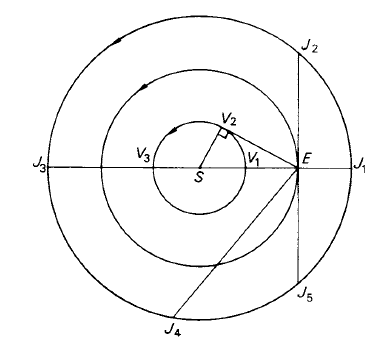
Planetary configurations
 المؤلف:
A. Roy, D. Clarke
المؤلف:
A. Roy, D. Clarke
 المصدر:
Astronomy - Principles and Practice 4th ed
المصدر:
Astronomy - Principles and Practice 4th ed
 الجزء والصفحة:
p 154
الجزء والصفحة:
p 154
 7-8-2020
7-8-2020
 2128
2128
Planetary configurations
At this stage it is convenient to define a number of terms frequently used in describing planetary configurations with respect to the Sun and the Earth. In figure 1, E refers to the Earth and S represents the Sun.
Planets are divided into two classes: those whose orbits lie within the Earth’s orbit are called

Figure 1. Planetary configurations.
inferior planets; those with orbits outside the Earth’s orbit are superior planets. Thus, in figure 1, the letters V and J refer respectively to an inferior and a superior planet.
We assume for the moment that planets move round the Sun in circular, coplanar orbits. The actual planetary orbits are ellipses of low eccentricity in planes inclined only a few degrees from each other so that the terms defined below are still applicable in the real cases.
A superior planet on the observer’s meridian at apparent midnight is said to be in opposition (configuration SE J1). It is obvious that an inferior planet cannot ever be in opposition.
A planet whose direction is the same as that of the Sun is said to be in conjunction (configurations EV1S, ESV3, ESJ3): an inferior planet can be in superior conjunction (configuration ESV3) or in inferior conjunction (configuration EV1S).
The angle the geocentric radius vector of the planet makes with the Sun’s geocentric radius vector is called the planet’s elongation (for example, angle SEV2 or SE J4). It is obvious that an inferior planet has zero elongation when it is in conjunction and maximum elongation (less than 90◦) when its geocentric radius vector is tangential to its orbit (configuration SEV2). The elongation of a superior planet can vary from zero (configuration SE J3) to 180◦ (configuration SE J1). When its elongation is 90◦, it is said to be in quadrature (configurations SE J2 and SE J5). These quadratures are distinguished by adding eastern or western. In figure 1, the north pole of the ecliptic is directed out of the plane of the paper so that J5 and J2 are in eastern and western quadratures respectively.
Another useful term relating the position of a planet with respect to the Sun and Earth is that of phase angle. This angle is defined by the Sun, the planet and the Earth. For the inferior planets, it can take a value in the range 0◦ to 180◦. In figure 1, the configuration SV2E depicts a phase angle of 90◦. For superior planets, the phase angle lies in the range 0◦ to a maximum value, this being determined according to the distance of the planet from the Sun.
 الاكثر قراءة في مواضيع عامة في علم الفلك
الاكثر قراءة في مواضيع عامة في علم الفلك
 اخر الاخبار
اخر الاخبار
اخبار العتبة العباسية المقدسة


